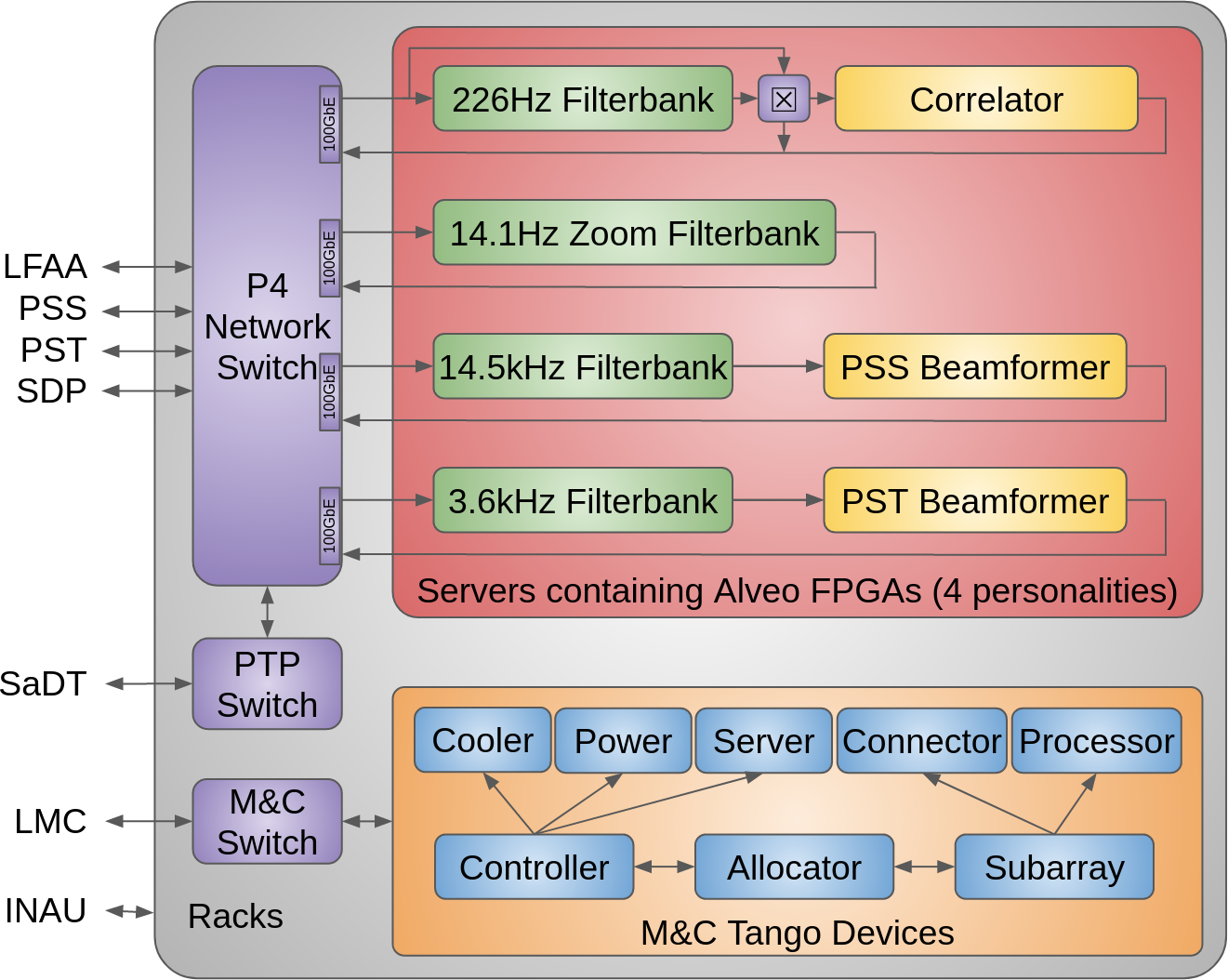This repository contains components that are common across multiple Low CBF Firmware personalities, including CI configuration and build scripts.
Low CBF Overview
This block diagram represents the Low CBF subsystem. The firmware personalities are represented by the four rows inside the large red box at top right.

Hardware Platform
Low CBF firmware is intended to run on Xilinx Alveo U55C FPGA cards.
The Alveo cards feature:
PCIe interface to a host PC
100GbE (100 Gigabit Ethernet) interface for signal data flow
High Bandwidth Memory (HBM). The HBM allows station data to be re-ordered for correlation. Station data is received as a time-based data stream and stored in the HBM. When a complete integration period is held in the HBM it is read out by frequency channel and a cross-correlation is performed for each frequency channel. Because the HBM is part of the FPGA rather than an external DIMM there is no need for power-hungry memory bus interfaces.
Each firmware personality is implemented as an accelerator Kernel using the Vitis software suite from Xilinx.
Vitis FPGA Accelerator Kernels
Designs compiled within the Vitis framework consist of two main elements:
An FPGA kernel with standardised interfaces which runs on an Alveo board.
A software application running on a host processor that controls the FPGA kernel over PCI Express.
FPGA Kernels compiled for Vitis have the following interfaces:
100GbE. This uses the 100GbE hard core in the FPGA, which is connected on the Alveo card to a QSFP.
AXI-lite slave interface. This is a compulsory AXI-lite slave with a standardised set of registers to control the kernel.
AXI-full interfaces. These interfaces access shared memory. The memory is shared with the host processor, in the sense that the host processor can access it. The shared memory can be either block ram in the FPGA or HBM.
The requirements for Vitis Accelerator kernels are described in detail in the Xilinx Vitis Unified Software Platform Documentation.
The software application interacts with the FPGA kernel by read and writing shared memory, and by writing to the AXI-lite slave interface.
Monitor and Control Interface
The Perentie FPGA kernel takes data in from LFAA via the 100GE interface, and outputs data to PSS, PST or SDP via the same 100GE interface. The processing is monitored and controlled via a large number of registers which are defined within the FPGA kernel. The software application running on the host processor is responsible for setting and reading these registers.
To allow access to the FPGA kernel’s internal register space, the kernel contains an interface to a shared memory block which it can copy register contents to/from.
To access the registers in the kernel:
The host software writes the address of the kernel registers it want to read/write
The host software writes the address of the shared memory to read/write from
The host software triggers the kernel to execute, i.e. copy data from internal registers to shared memory (or from shared memory to internal registers)
The kernel reports done once the copy is complete, and the host can access any register contents in the shared memory pool.
This is illustrated in the diagram below. The Interconnect and signal processing registers within the kernel are generated using the Automatic Register Generation System (ARGS), which has been developed jointly by Astron and CSIRO.

The Xilinx XRT driver is required to communicate to the Alveo cards. See also XRT’s documentation.
The software library that Low CBF uses to monitor & control the FPGAs is ska-low-cbf-fgpa.
Firmware Roadmap
See the Perentie Program Increment Roadmap on Confluence.
Building Firmware
The build process is automated, and GitLab CI Configuration is provided. Refer to Using The Build Scripts for instructions on how to perform a local build.
Behind the scenes, a software tool RadioHDL (to be moved to the common repository later) is used to automate building registers in the firmware design and creating a Project File so that the Xilinx tools can compile the firmware. The process to use RadioHDL to build code is described on SKA Confluence.
Vivado and Vitis are licensed software. Some of the IP included in the design is also licensed software.